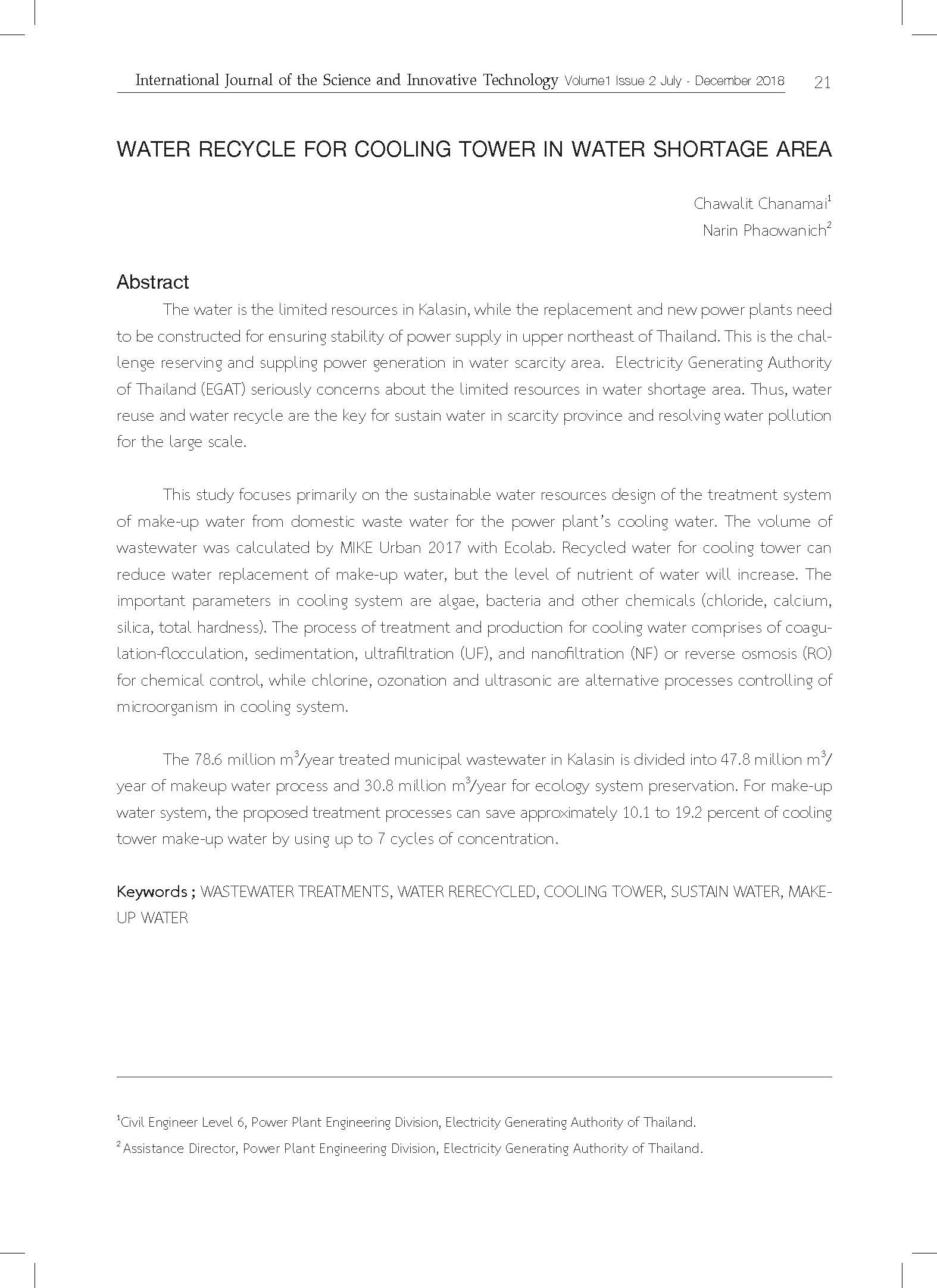Water Reuse for Cooling Tower in Water Shortage Area
Main Article Content
Abstract
The water is the limited resources in Kalasin, while the replacement and new power plants need to be constructed for ensuring stability of power supply in upper northeast of Thailand. This is the challenge reserving and suppling power generation in water scarcity area. Electricity Generating Authority of Thailand (EGAT) seriously concerns about the limited resources in water shortage area. Thus, water reuse and water recycle are the key for sustain water in scarcity province and resolving water pollution for the large scale.
This study focuses primarily on the sustainable water resources design of the treatment system of make-up water from domestic waste water for the power plant’s cooling water. The volume of wastewater was calculated by MIKE Urban 2017 with Ecolab. Recycled water for cooling tower can reduce water replacement of make-up water, but the level of nutrient of water will increase. The important parameters in cooling system are algae, bacteria and other chemicals (chloride, calcium, silica, total hardness). The process of treatment and production for cooling water comprises of coagulation-flocculation, sedimentation, ultrafiltration (UF), and nanofiltration (NF) or reverse osmosis (RO) for chemical control, while chlorine, ozonation and ultrasonic are alternative processes controlling of microorganism in cooling system.
The 78.6 million m3/year treated municipal wastewater in Kalasin is divided into 47.8 million m3/year of makeup water process and 30.8 million m3/year for ecology system preservation. For make-up water system, the proposed treatment processes can save approximately 10.1 to 19.2 percent of cooling tower make-up water by using up to 7 cycles of concentration.
Article Details
References
R. L. Everette, H. L. Anderson and L. K. Mcgrath,
2011. Membrane treatment of side-stream cooling
tower water for reduction of water usage, The
International Journal on the Science and Technology
of Desalting and Water Purification.
American Society for Testing and Material (ASTM),
2008. ASTM Standard D4778-05, Standard test
method for determination of corrosion and fouling
tendency of cooling water under heat transfer
conditions. Pennsylvania, USA American Society
for Testing and Material (ASTM).
Department of Disaster Prevention and Mitigation
(DDPM), 2017. Data of Drought risk Area, Nation
Disaster Warning Center, Thailand, Department
of Disaster Prevention and Mitigation, Ministry of
Interior, Thailand (Original in Thai).
DHI, 2013. Hampton Roads Sanitation District Selects
Mike Urban for the Regional Hydraulic Model,
MIKE Powered by DHI.
Energy Policy and Planning Office (EPPO), 2015. Thailand
Power Development Plan 2015-2036, Energy
Policy and Planning Office, Ministry of Energy
(Original in Thai).
Federal Energy Management (FEMP), 2011. Cooling
Towers: Understanding Key Components of Cooling
Towers and How to Improve Water Efficiency,
Energy Efficiency & Renewable Energy, U.S. Department
of Energey.
Jhansi, S. C., M. S. Campus and S. K. Mishra, 2013.
Wastewater Treatment and Reuse: Sustainbility
Options, Consilience: The Journal of Sustainable
Development, Vol. 10, Iss. 1 (2013), Pp. 1 – 15.
JRA GL02-1994, 1994. Guideline of Water Quality for
Refrigeration and Air Conditioning Equipment,
Japan Refrigeration and Air Conditioning Industry
Association.
Office of Natural Resources and Environmental policy
and Planning (ONPE), 2017. Solid Waste Management
System and Community Wastewater
Management System, Office of Natural Resources
and Environmental policy and Planning, Thailand
(Original in Thai).
Public Relations Province (PRD), 2017. Kalasin Provincial
development plan 2018-2021, Public Relations
Province, Kalasin, Thailand (Original in Thai).
Seneviratne, M. (2006). A Practical Approach to Water
Conservation for Commercial and Industrial
Facilities. United Kingdom, Butterworth-Heinemann.
Walters, J. and D. Duke, 2007. Effective Use of Recycled
Water in Cooling Towers with New Green Technology,
West Basin Municipal Water District.
WQPN, 2007. Cooling tower wastewater management
and disposal, Department of Water, Government
of Western Australia


